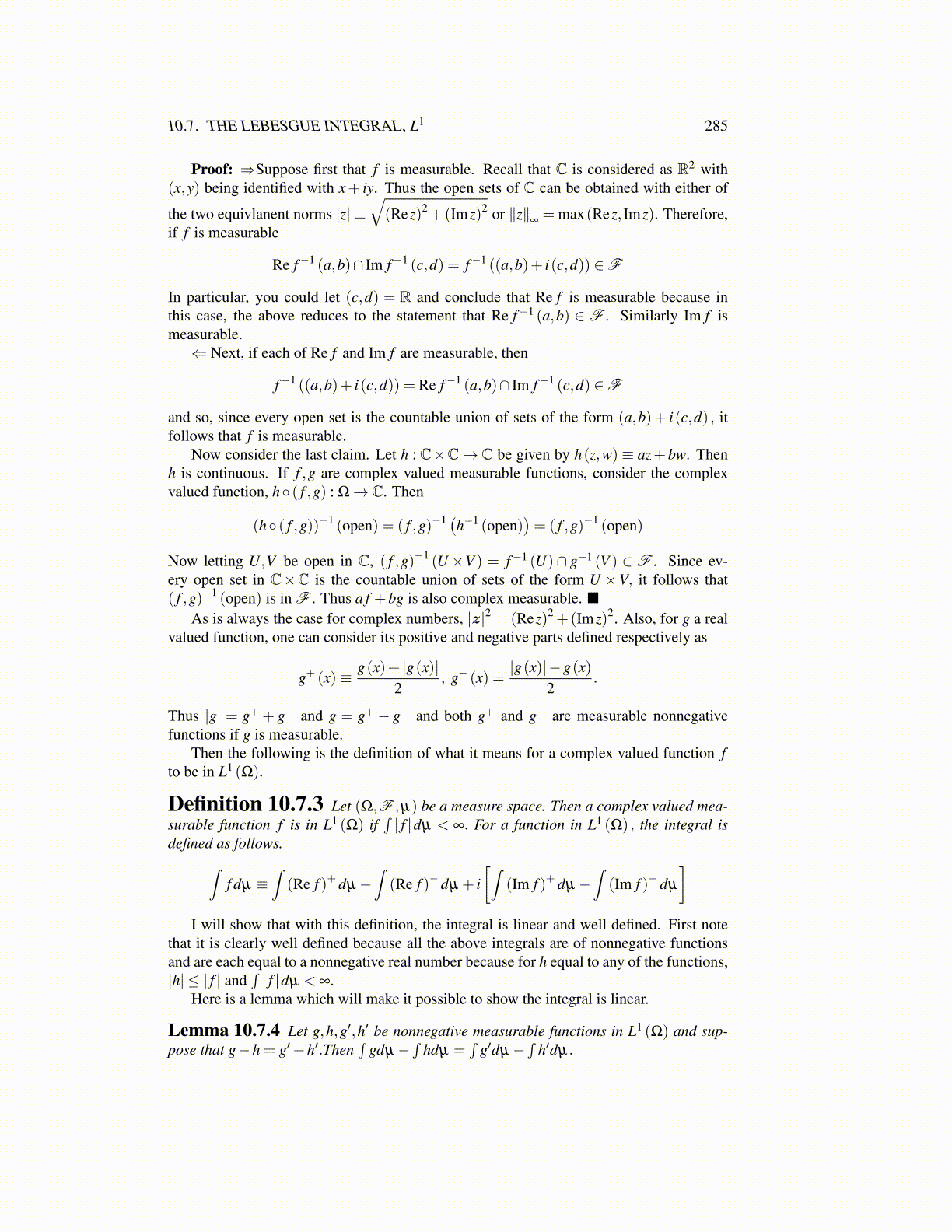
10.7. THE LEBESGUE INTEGRAL, L1 285
Proof: ⇒Suppose first that f is measurable. Recall that C is considered as R2 with(x,y) being identified with x+ iy. Thus the open sets of C can be obtained with either of
the two equivlanent norms |z| ≡√(Rez)2 +(Imz)2 or ∥z∥
∞= max(Rez, Imz). Therefore,
if f is measurable
Re f−1 (a,b)∩ Im f−1 (c,d) = f−1 ((a,b)+ i(c,d)) ∈F
In particular, you could let (c,d) = R and conclude that Re f is measurable because inthis case, the above reduces to the statement that Re f−1 (a,b) ∈ F . Similarly Im f ismeasurable.⇐ Next, if each of Re f and Im f are measurable, then
f−1 ((a,b)+ i(c,d)) = Re f−1 (a,b)∩ Im f−1 (c,d) ∈F
and so, since every open set is the countable union of sets of the form (a,b)+ i(c,d) , itfollows that f is measurable.
Now consider the last claim. Let h : C×C→ C be given by h(z,w) ≡ az+bw. Thenh is continuous. If f ,g are complex valued measurable functions, consider the complexvalued function, h◦ ( f ,g) : Ω→ C. Then
(h◦ ( f ,g))−1 (open) = ( f ,g)−1 (h−1 (open))= ( f ,g)−1 (open)
Now letting U,V be open in C, ( f ,g)−1 (U×V ) = f−1 (U)∩ g−1 (V ) ∈ F . Since ev-ery open set in C×C is the countable union of sets of the form U ×V, it follows that( f ,g)−1 (open) is in F . Thus a f +bg is also complex measurable. ■
As is always the case for complex numbers, |z|2 = (Rez)2 +(Imz)2. Also, for g a realvalued function, one can consider its positive and negative parts defined respectively as
g+ (x)≡ g(x)+ |g(x)|2
, g− (x) =|g(x)|−g(x)
2.
Thus |g| = g+ + g− and g = g+ − g− and both g+ and g− are measurable nonnegativefunctions if g is measurable.
Then the following is the definition of what it means for a complex valued function fto be in L1 (Ω).
Definition 10.7.3 Let (Ω,F ,µ) be a measure space. Then a complex valued mea-surable function f is in L1 (Ω) if
∫| f |dµ < ∞. For a function in L1 (Ω) , the integral is
defined as follows.∫f dµ ≡
∫(Re f )+ dµ−
∫(Re f )− dµ + i
[∫(Im f )+ dµ−
∫(Im f )− dµ
]I will show that with this definition, the integral is linear and well defined. First note
that it is clearly well defined because all the above integrals are of nonnegative functionsand are each equal to a nonnegative real number because for h equal to any of the functions,|h| ≤ | f | and
∫| f |dµ < ∞.
Here is a lemma which will make it possible to show the integral is linear.
Lemma 10.7.4 Let g,h,g′,h′ be nonnegative measurable functions in L1 (Ω) and sup-pose that g−h = g′−h′.Then
∫gdµ−
∫hdµ =
∫g′dµ−
∫h′dµ.